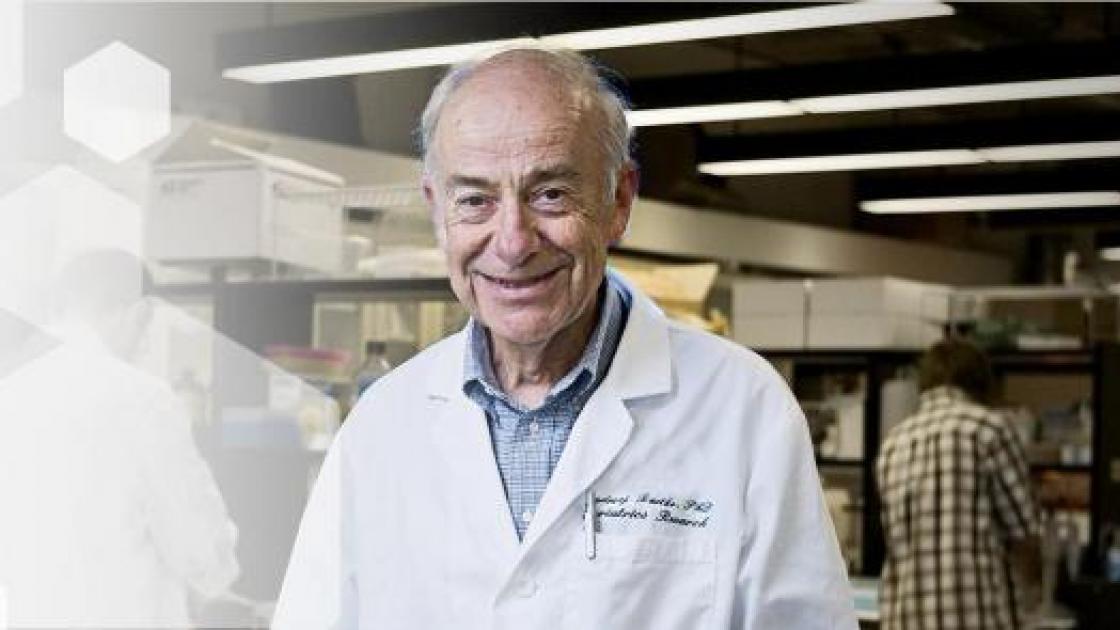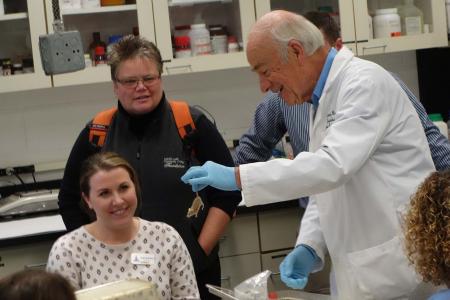
Geriatrics Research
Welcome from Dr. Bartke
Most of the work in our laboratory is directed at the hormonal control of mammalian aging
Our interest in this topic stems from our demonstration that mice with a genetic deficiency of growth hormone (GH) production by the pituitary gland live much longer than their normal siblings. Our report of these findings (Brown-Borg et al., Nature, 1996) was the first demonstration that mutation of a single gene can extend longevity in a mammal. Our subsequent studies have shown that these (as well as other GH-related mutants) not only live much longer, but also stay healthy and retain youthful characteristics (including ability to learn and remember into advanced age). We are particularly interested in using results of these studies to identify practical interventions that could be used to reduce risk of age-related chronic diseases and promote healthy aging in people. Studies ongoing in our laboratory and research methods we employ are briefly described below.
Mechanisms finding growth hormone signaling with healthy aging and longevity
Data obtained to date indicate that growth hormone (GH) influences aging and longevity by a variety of interacting mechanisms. To identify and explore these mechanisms, we are using mice in which suppression of GH action by mutations causing GH deficiency or GH resistance is associated with a remarkable extension of longevity, and transgenic mice in which excessive production of GH is associated with drastic reduction of longevity. In recent and ongoing studies, we are monitoring glucose homeostasis, energy metabolism, thermogenesis, and anti-inflammatory cytokines, along with growth, maturation, and expression of genes related to these processes.
Effects of environmental temperatures on healthy aging and longevity
We have shown that long-lived GH-related mutants have more thermogenic (brown adipose) tissue, greater activity of this tissue, along with alterations in metabolic rate and in utilization of different energy substrates (fatty acids vs carbohydrates). We are exposing both long-lived mutants and normal animals to different environmental temperatures to induce changes in energy metabolism and characterizing the impact of these environmental interventions on profiles of gene expression in different tissues and on phenotypic characteristics which predict the rate of aging, the risks of chronic disease, and length of life.
Pharmacological interventions to slow down the process of aging
We have already shown that hormonal intervention during the period of rapid growth before and around the time of puberty can profoundly alter adult aging-related characteristics and determine how long an animal can live. We are now testing the effects of early life treatment with drugs which affect glucose homeostasis, anabolic processes, growth, accumulation of senescent cells, or levels of endogenous compounds known to promote aging. Our objective is to identify interventions that could extend the health span (period of life free of disability and chronic disease) and perhaps also improve the chances of reaching advanced age.
Research Methods
We routinely use tests for glucose and insulin tolerance, indirect calorimetry, measuring expression of selected genes by quantitative real time polymerase chain reaction (RT-PCR) and measuring the levels of the corresponding proteins and phosphoproteins by western blot. In collaboration with other laboratories, we are employing a variety of other techniques indicating RNA sequencing, studies of chromatin modifications, behavioral studies, and histology.
Representative publications
Li X, McPherson M, Hager M, Fang Y, Bartke A, Miller RA. Transient early life growth hormone exposure permanently alters brain, muscle, liver, macrophage, and adipocyte status in long-lived Ames dwarf mice. FASEB J 2022; 36(7): e22394.
Bartke A, Sun LY, Li X, Miller RA. Early Life Interventions Can Shape Aging. Frontiers in endocrinology 2022; 13: 797581.
Schneider A, Victoria B, Schiavon Cousen MI, et al. Growth Hormone Signaling Shapes the Impact of Environmental Temperature on Transcriptomic Profile of Different Adipose Tissue Depots in Male Mice. J Gerontol A Biol Sci Med Sci 2022; 77(5): 941-6.
Bartke A, Hascup E, Hascup K, Masternak MM. Growth Hormone and Aging: New Findings. World J Mens Health 2021; 39(3): 454-65.
Fang Y, McFadden S, Darcy J, Hascup ER, Hascup KN, Bartke A. Lifespan of long-lived growth hormone receptor knockout mice was not normalized by housing at 30 degrees C since weaning. Aging Cell 2020; 19(5): e13123.
Aguiar-Oliveira MH, Bartke A. Growth Hormone Deficiency: Health and Longevity. Endocr Rev 2019; 40(2): 575-601.
Darcy J, Bartke A. From White to Brown - Adipose Tissue Is Critical to the Extended Lifespan and Healthspan of Growth Hormone Mutant Mice. Adv Exp Med Biol 2019; 1178: 207-25.
Darcy J, McFadden S, Fang Y, et al. Increased environmental temperature normalizes energy metabolism outputs between normal and Ames dwarf mice. Aging (Albany NY) 2018; 10(10): 2709-22.
Fang Y, Hill CM, Darcy J, et al. Effects of rapamycin on growth hormone receptor knockout mice. Proc Natl Acad Sci U S A 2018; 115(7): E1495-E503.
Sun LY, Fang Y, Patki A, et al. Longevity is impacted by growth hormone action during early postnatal period. Elife 2017; 6.

Geriatrics Research Laboratory
Dr. Andrzej Bartke, Director of SIU's Aging & Longevity Research Laboratory, has won several major research awards, including the Methuselah award for generating the world's oldest mouse.
When he isn't lecturing around the world, he and his team of laboratory scientists work to gather research on the effects of growth hormones and caloric restriction on aging.

